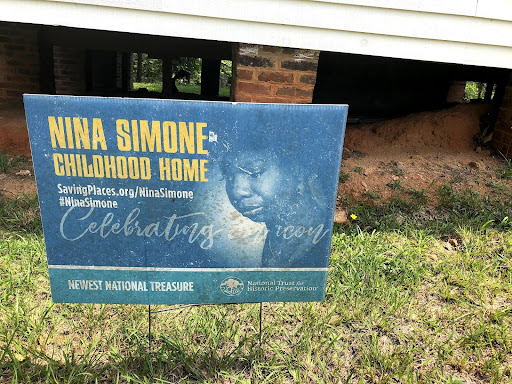 Via Annie Chester.
Via Annie Chester.
On February 21, 1933, Eunice Kathleen Waymon came into the world in Tryon, North Carolina, as the sixth child of eight for John and Mary Kate Waymon. A rare musical talent, Eunice shared her gifts with her community in Tyron before becoming the artist and activist professionally known as Nina Simone.

Simone’s first stage was the church. Her mother was a Methodist minister and on the piano, Simone would accompany her mother’s sermons and the church choir. At 6 years old, Simone accompanied the community choir at the Tryon Theatre. Noticing Simone’s talent, Muriel Mazzanovich, a British transplant to Tryon, gave Simone formal piano lessons at her home.
Tryon residents gave money to fund Simone’s studies at Allen High School for Girls in Asheville, North Carolina. At the boarding school, she honed her piano skills and graduated valedictorian. After graduation, Simone went to New York for a summer program at Julliard. She planned to move to Philadelphia after that summer to attend the prestigious Curtis Institute of Music. Her parents had moved to Philadelphia, sure that their daughter would be accepted. However, Simone was rejected.
Having her dreams of attending the Curtis Institute of Music dashed, Simone worked as an accompanist and piano teacher to make money. She eventually ended up at an Atlantic City, New Jersey cocktail bar, playing the piano and singing. She had never sung before then. Trying to hide her new unholy singing career from her religious mother, Eunice changed her name to Nina Simone.
Simone’s sultry, distinct voice sent her on a trajectory to stardom. She made her first demo in Philadelphia in 1954. In 1959, following a short-lived record deal, Simone moved to New York and signed with Colpix Records. Her subsequent albums gained commercial popularity.
While Simone’s professional career was a success, she experienced various personal struggles. In 1961, Simone married her second husband Andrew Stroud, a Harlem police detective who later became her manager. They had a daughter, Lisa, together. Stroud beat Simone while the couple built Simone’s successful career. They later divorced in 1970. Simone struggled with her mental health for many years. All the while, the Civil Rights Movment was going on. Having endured a lifetime of racism, Simone used her music to fight against injustice.
Angered by the 16th Street Baptist Church bombing, a white supremacist terror attack in Birmingham, Alabama on September 15, 1963 that killed four young Black girls, Simone penned the song “Mississippi Goddamn”. The song mourns the girls’ death and the murder of civil rights activist Medgar Evers in Mississippi, in addition to “voicing anguish about all the acts of violence and oppression against Black communities in the segregated South.” Simone considered this her first civil rights song.
In 1965, Simone performed during the Selma-to-Montgomery March. The same year, following the passing of playwright and friend, Lorraine Hansberry, Simone turned one of Hansberry’s unfinished works into the song, “To Be Young, Gifted, and Black”. She also transformed a Langston Hughes’ poem “Backlash Blues” into a song of the same name.
In 1974, Simone went to live abroad in Liberia. After two years, she moved to Switzerland and then France. Throughout this period, Simone struggled mentally and fiancially. In a 1999 BBC interview, she discusses how her personal life was in shambles. When she needed money she would perform in the U.S. In 1987, her 1959 song “My Baby Just Cares for Me” became popular in Europe, helping her fiancially. Her disdain for the U.S. kept her from living there again. She did, however, visit on tour until breast cancer forced her to retire. She later died in France.
 Nina Simone’s childhood home in Tryon. Via Annie Chester.
Nina Simone’s childhood home in Tryon. Via Annie Chester.
In 2017, Simone’s childhood home, after years of standing empty, went up for sale. Four New York-based African American artists–Adam Pendleton, Rashid Johnson, Ellen Gallagher, and Julie Mehretu–purchased the home as a political act. With the help of the National Trust, Nina Simone Project, World Monuments Fund, and North Carolina African American Heritage Commission, the artists are working to preserve her Tryon home and legacy for generations to come.
The house is not yet open to the public, as plans for its reuse are in the works. Nevertheless, you can drive by the home and walk the streets of Tryon, where a monument of Simone stands downtown.
 Nina Simone statue in Tryon. Via Annie Chester.
Nina Simone statue in Tryon. Via Annie Chester.
Have you visited Tryon? Do you have questions, comments, or concerns about this story? Reach out to Annie at achester@expatalachians.com
Subscribe to The Patch, our newsletter, to stay up-to-date with new expatalachians articles and news from around Appalachia.


